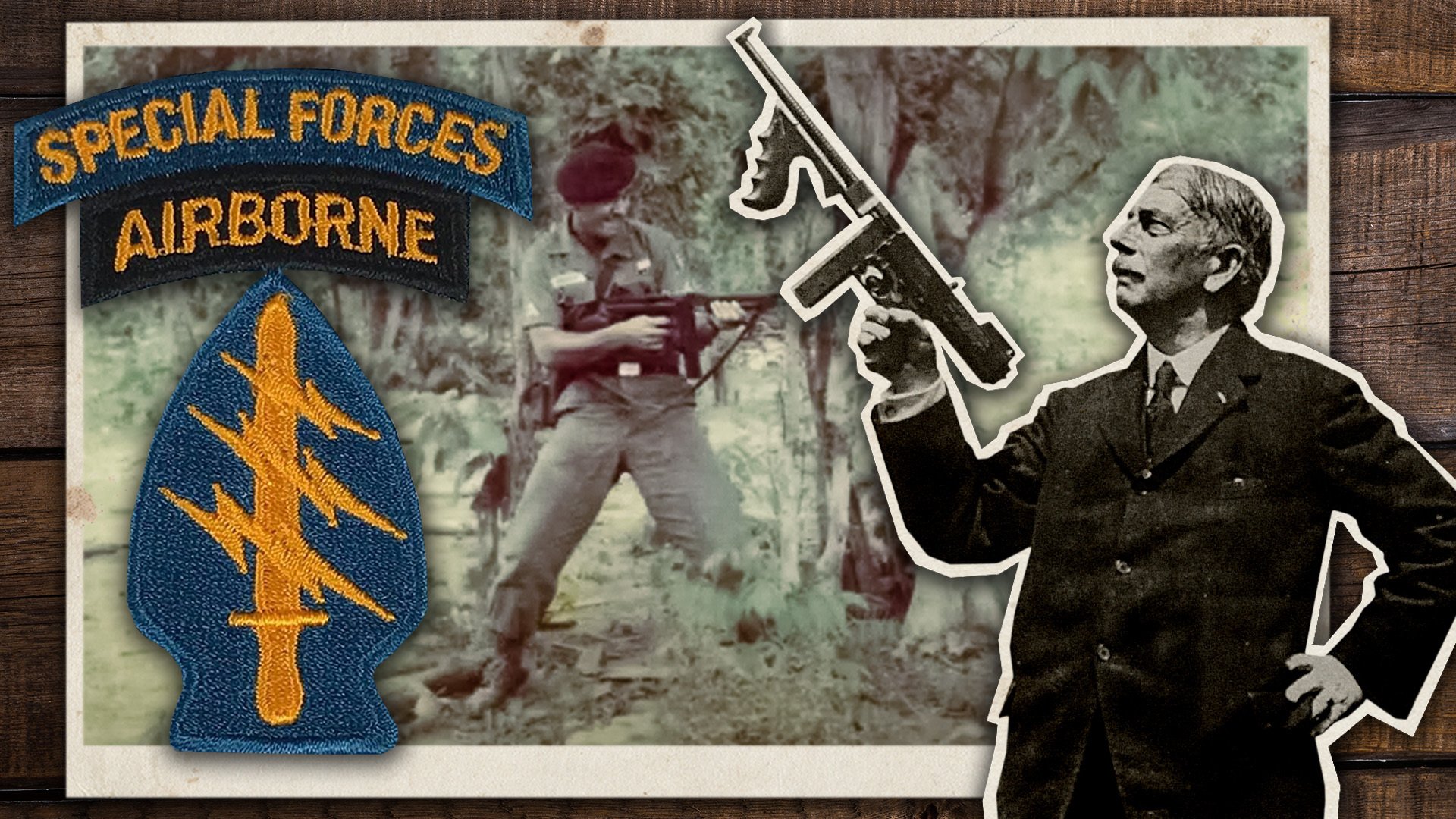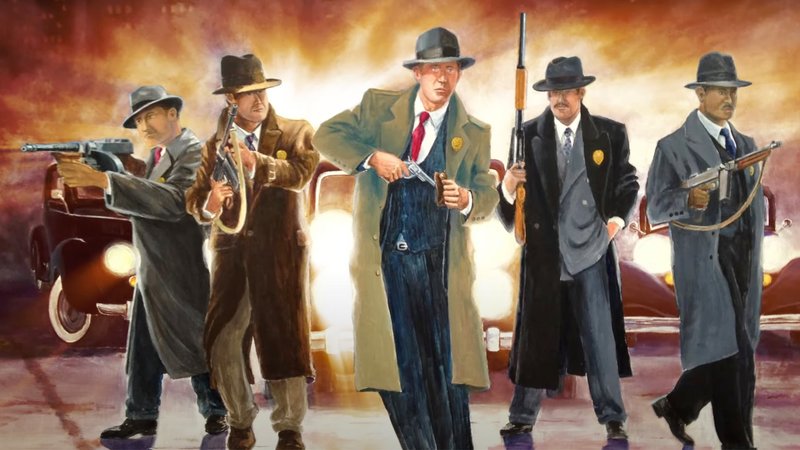
The Thompson submachine gun, sometimes called the “Tommy Gun,” was used by federal law enforcement officers, gangsters, and even elite commandos. Photo courtesy of Army Special Forces Hall of Fame member Bob Charest. Composite by Kenna Lee.
The Thompson submachine gun, or “Tommy Gun,” was one of the most widely used weapons during the 20th century. Initially conceived as a “trench broom” for American troops in World War I, its prevalence and notoriety grew from there. In future decades, the Thompson would prove useful for a variety of gunslingers, including federal law enforcement officers, gangsters, and elite commandos.
Why did the Tommy Gun become the weapon of choice for so many shooters in the industrialized world? Here we explore the answer to that question and more.
Related: The Rambo Knife: From Survival Tool to ‘Heartstopper’
America’s First Submachine Gun

John T. Thompson was instrumental in the development of several iconic weapons. He developed the Thompson submachine gun as a new weapon’s class between the M1913 Springfield rifle and the M1911 pistol. Photos courtesy of Wikimedia Commons. Composite by Matt Fratus/Coffee or Die.
The idea for America’s first submachine gun was born from the mind of inventor John T. Thompson. A United States Military Academy at West Point graduate and veteran of the Spanish-American War, Thompson already had extensive experience in the firearms industry. He supervised the development of the M1903 Springfield rifle, which was first fielded in 1903 and later used in both world wars. Thompson was also known for having conducted ballistics tests on beef cattle to determine the best pistol cartridge for the US Army — an endeavor that ultimately led to the creation of the Colt .45 M1911.
In 1916, Thompson founded the Auto-Ordnance Company with a vision to develop a submachine gun that could clean out a trench in a single burst. The weapon he had in mind would be an “intermediate” automatic weapon in the ballistic class between the pistol and rifle. He nicknamed his contraption the “Trench Broom.” Although the gun wasn’t completed in time to see action in World War I, Thompson continued to refine the concept, predicting that there would be plenty of need for it in future conflicts.
Throughout the 1920s, Thompson developed various models of the Tommy Gun for clients, including the US military and federal law enforcement agencies.
Notably, one of Thompson’s biggest initial clients was the Irish Republican Army. Thanks to its popularity among Irish-American gangsters, the Tommy Gun soon came on the radar of Michael Collins, the Minister of Finance of Ireland and Director of Intelligence for the IRA. The famous revolutionary raised enough capital to submit an order for about 500 Tommy Guns at $225 a piece. The weapons were first used in the Irish War of Independence in June 1921, when a group of IRA Volunteers ambushed a British troop train near Drumcondra, an inner suburb of Dublin, and inflicted numerous casualties. No one was killed in the skirmish.
Meanwhile, in the United States, the Thompson was making headlines for its role in intense shootouts between lawmen and criminals.
Luck o’ the Irish: Check out Fool’s Gold, BRCC’s Irish cream roast, just in time for St. Patrick’s Day!
Gangsters and G-Men

The US Postal Inspection Service were among the first federal agents to be equipped with Thompson submachine guns. Screengrab from YouTube.
In 1920, the US Postal Inspection Service incorporated the Thompson submachine gun into its arsenal to become the nation’s first federal law enforcement agency to field the weapon. The decision to do so was a response to a surge in armed robberies of mail carriers. Mail bandits, often targeting trains and trucks, could steal between $500,000 and $2 million in a single strike.
Following the USPS’s lead, FBI agents and other “Government men” — or G-men, as they were called — started carrying Thompsons as well.
The feds weren’t the only ones who benefitted from the Thompson. During Prohibition, as organized crime activity increased across the US, infamous gangsters used submachine guns to carry out assassinations. Irish hitman Frank McErlane, one of Al Capone’s most merciless goons, is credited with introducing the Thompson to Chicago’s criminal underworld. The weapon’s frequent usage in the city earned it many nicknames, including the “Tommy Gun” and the “Chicago Typewriter.”
According to the Mob Museum, the popularity of the Tommy Gun among Irish-American and Italian-American gangsters in the 1920s and 1930s is what ultimately led Congress to pass the National Firearms Act. Signed into law in 1934, the bill stipulated that anyone who owned a Tommy Gun had to register the weapon with the Alcohol Tax Unit, which later became the Bureau of Alcohol, Tobacco, & Firearms.
Related: The US Postal Inspection Service: America’s First and Oldest Federal Law Enforcement Agency
World War II Medal of Honor

1st Sgt. Leonard Funk Jr., a US Army Airborne paratrooper, used his Thompson submachine gun to decimate Nazi soldiers during World War II. He was awarded the Medal of Honor. Wikimedia Commons photo. Composite by Matt Fratus/Coffee or Die.
Prior to America’s involvement in World War II, the Thompson was considered an auxiliary weapon system. However, as elite American units began deploying to the frontlines, many of their members, from Airborne Rangers to Marine Raiders, opted to carry the M1A1 Thompson as their primary weapon. One soldier who did was 1st Sgt. Leonard Funk Jr., a paratrooper awarded the Medal of Honor for his actions in the Battle of the Bulge.
On Jan. 29, 1945, Funk’s unit encountered a group of more than 80 Nazi soldiers in a small Belgian village called Holzheim. The Germans ordered Funk and his men to surrender — but they didn’t. Instead, Funk raised his Thompson and emptied the entire 30-round magazine into the Germans. A lopsided battle ensued. When the dust settled, 21 Nazis were dead and many more were wounded. The survivors were taken prisoner of war.
Related: From World War II to US Customs, Neal McCallum’s 46 Years Dedicated to Uncle Sam
The Thompson and Army Special Forces

Bob Charest, an Army Special Forces soldier who later served with MACV-SOG and Detachment-A in Berlin, relied on the Thompson submachine gun for base defense while in Vietnam. Photos courtesy of Bob Charest. Composite by Matt Fratus/Coffee or Die.
In 1963, US Army Special Forces soldier Bob Charest was sent to Vietnam as an adviser. His 12-man team, code-named A-432, was tasked with training 200 Jari Montagnards, whom they would ultimately accompany into combat.
The Green Berets and their local allies operated in the jungle and frequently set up defensive camps in the area of Boun Beng. The team had access to a large arsenal of weaponry that included everything from the German Schmeisser MP40 submachine gun to the M1 rifle. Charest, who was later inducted into the Army Special Forces Hall of Fame, found that the Thompson was the best option for base defense.
“We had a man on duty every night to patrol the camp, and we carried the Thompson because the .45 caliber had knockdown power,” Charest recalled in a recent interview with Coffee or Die. “In our tiny mess hall or team room, we had three Thompsons on both sides available for immediate access in case of a sudden attack, six in all, locked and loaded and well-oiled at all times by our weapons men.”
Eventually, however, Charest discovered that the Thompson had its limitations. First, its effective range was under 100 yards, making it virtually useless in long-range engagements. Second, the Thompson weighed about 10 pounds without a magazine. Add one, plus a few extra packed into a shoulder or belt bag, and the weight became a problem.
The Thompson was eventually phased out of the American arsenal, primarily because of its lack of range, heavy weight, and uncommon bullet caliber. As it and other shoulder-fired weapons that had been popular in previous conflicts went the way of the dodo, the M16 and its 5.56 ammunition became standard issue for US troops in the Vietnam War.
Read Next: Detachment A: How Special Forces Soldiers Operated Undercover in Cold War Berlin
Editor’s Note 3/21/2023: This article was updated to include additional information about the use of the Tommy Gun by the Irish Republican Army.

Matt Fratus is a history staff writer for Coffee or Die. He prides himself on uncovering the most fascinating tales of history by sharing them through any means of engaging storytelling. He writes for his micro-blog @LateNightHistory on Instagram, where he shares the story behind the image. He is also the host of the Late Night History podcast. When not writing about history, Matt enjoys volunteering for One More Wave and rooting for Boston sports teams.
BRCC and Bad Moon Print Press team up for an exclusive, limited-edition T-shirt design!
BRCC partners with Team Room Design for an exclusive T-shirt release!
Thirty Seconds Out has partnered with BRCC for an exclusive shirt design invoking the God of Winter.
Lucas O'Hara of Grizzly Forge has teamed up with BRCC for a badass, exclusive Shirt Club T-shirt design featuring his most popular knife and tiomahawk.
Coffee or Die sits down with one of the graphic designers behind Black Rifle Coffee's signature look and vibe.
Biden will award the Medal of Honor to a Vietnam War Army helicopter pilot who risked his life to save a reconnaissance team from almost certain death.
Ever wonder how much Jack Mandaville would f*ck sh*t up if he went back in time? The American Revolution didn't even see him coming.
A nearly 200-year-old West Point time capsule that at first appeared to yield little more than dust contains hidden treasure, the US Military Academy said.












